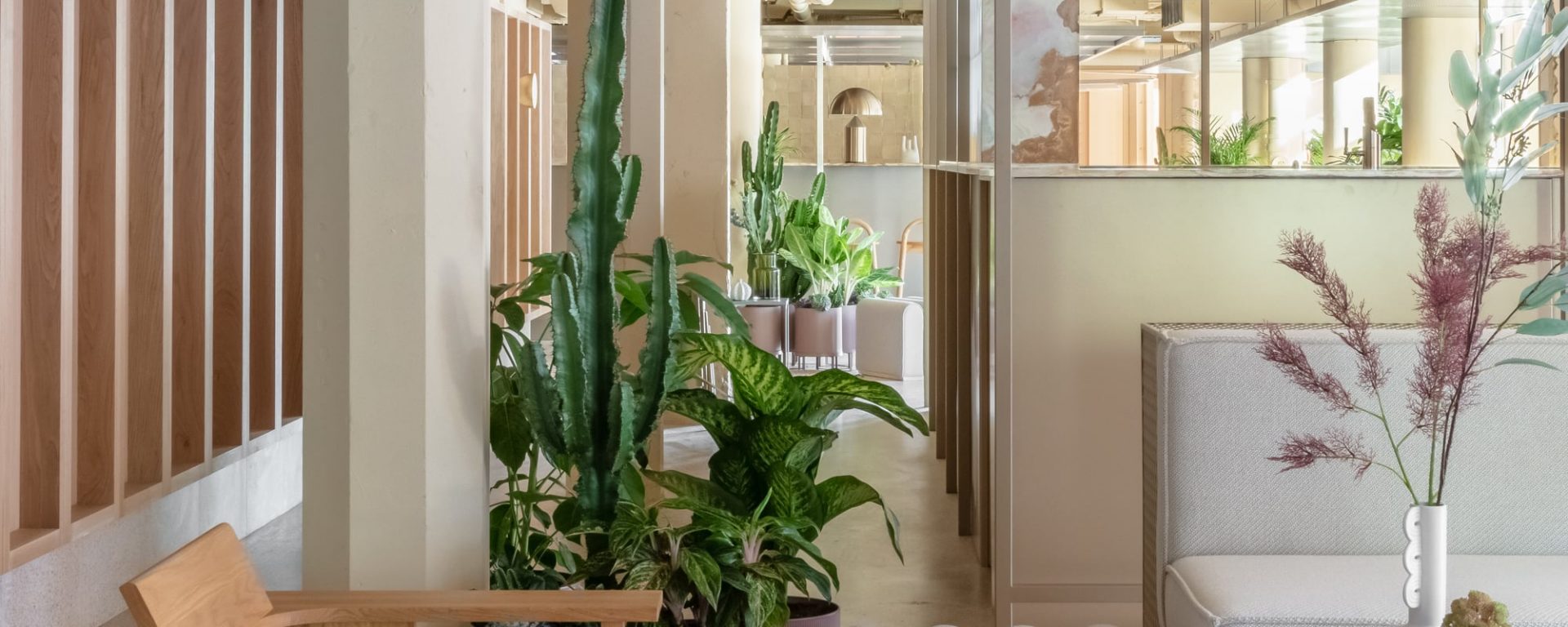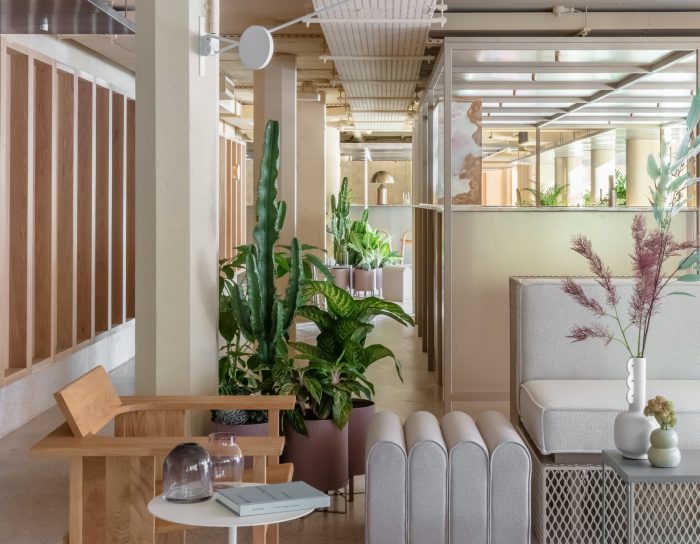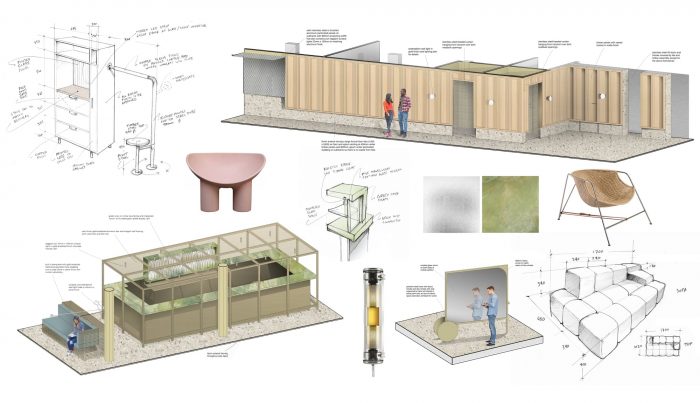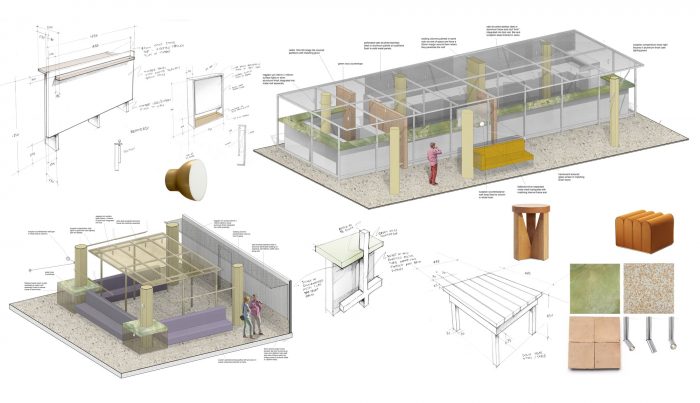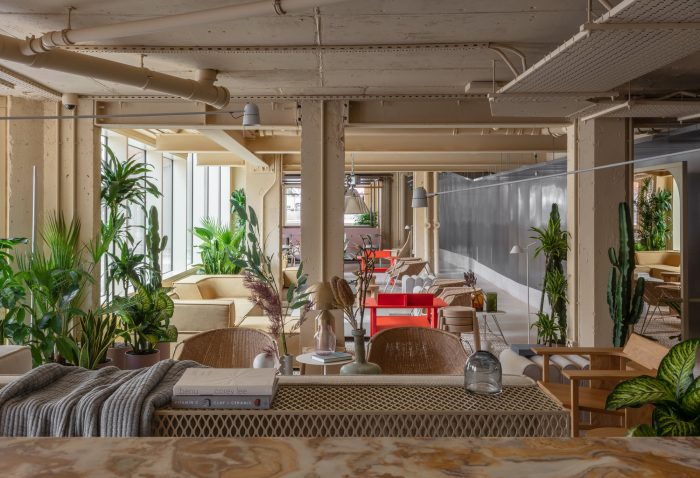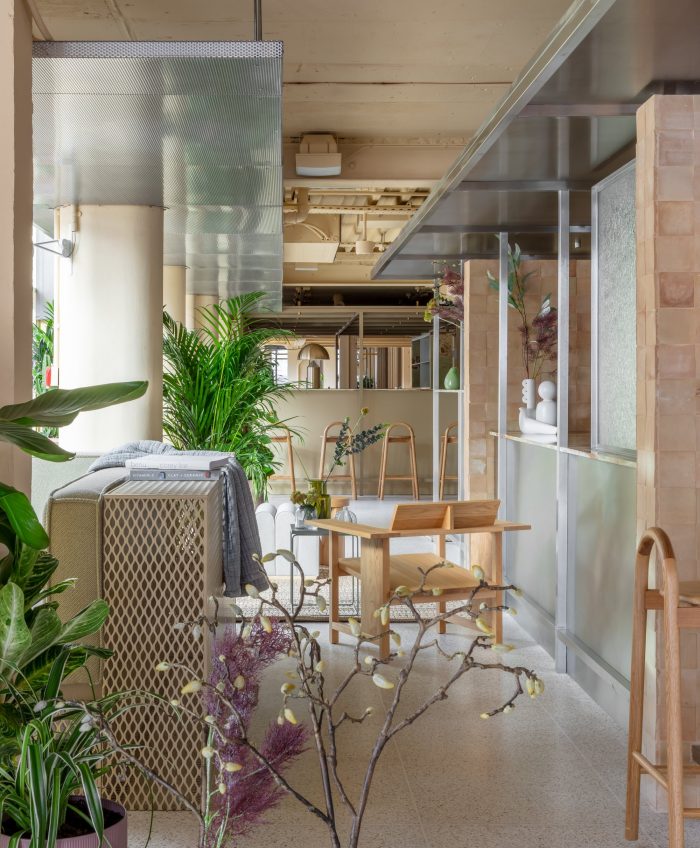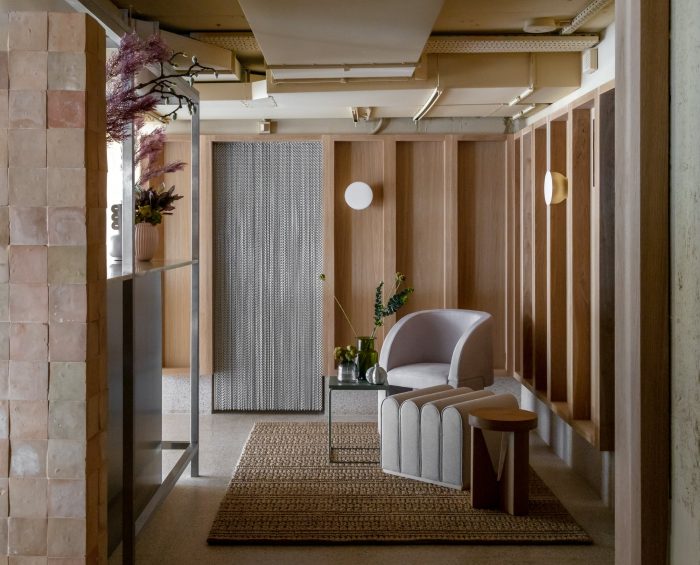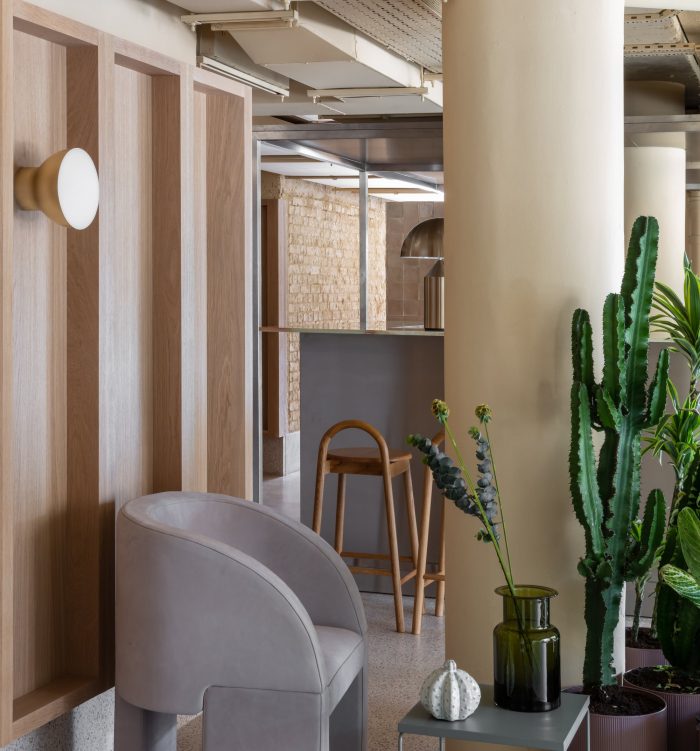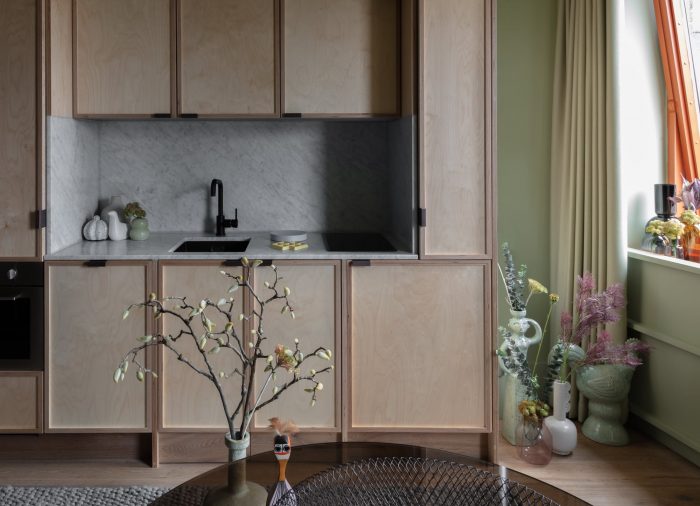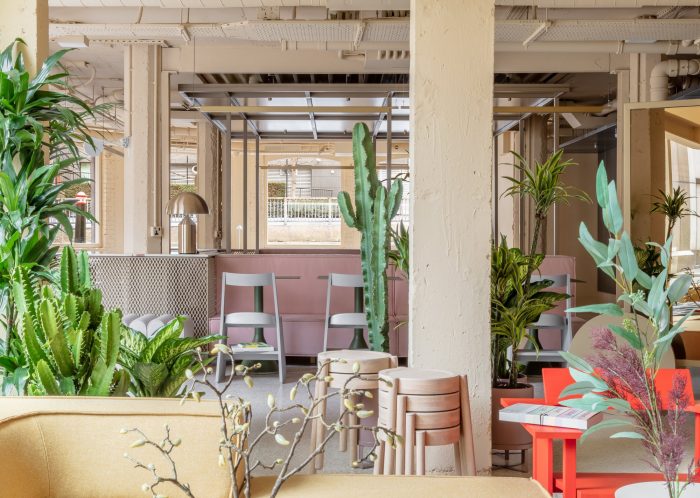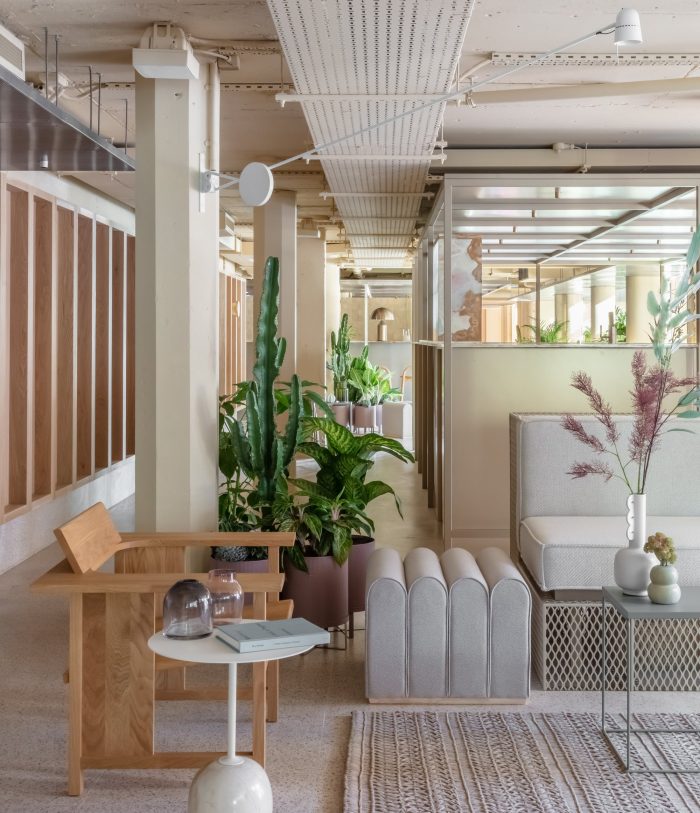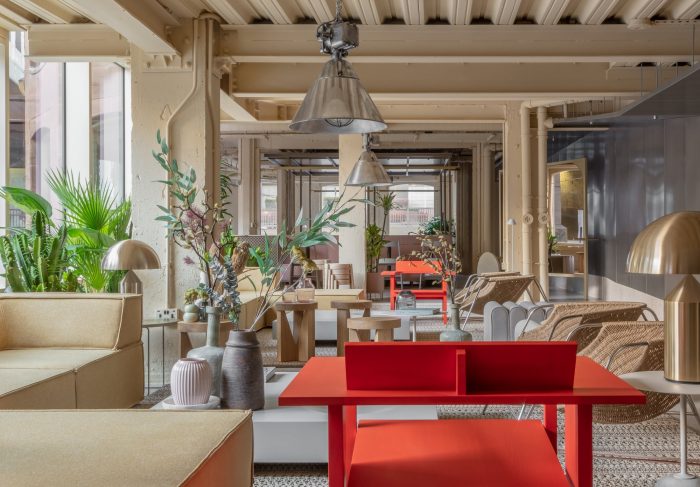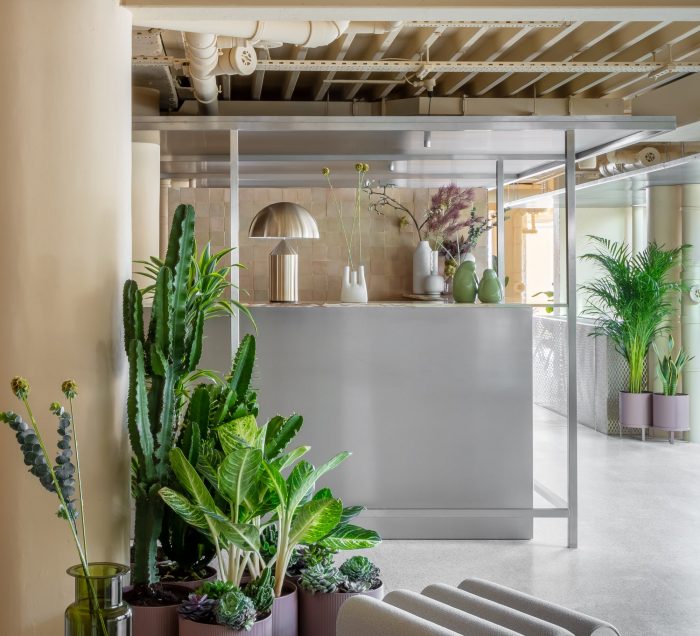Locke at Broken Wharf是我们在英国伦敦设计的一个拥有113个房间的酒店,包括酒吧、餐厅、休息室和协同工作空间。这个适应性再利用项目包括对位于英国首都中心的一栋现有的七层办公楼进行加建、全面翻新和全面装修。虽然该地块令人难以置信的河边位置是一个真正的礼物,但我们准备改造的这个废弃的商业区却不太适合做酒店项目。
Locke at Broken Wharf is a 113 room hotel with a bar, restaurant, lounge and coworking space that we designed in London, England. This adaptive reuse project comprised an addition, complete gut renovation and comprehensive fit out of an existing seven story office building in the very heart of the British capital. While the incredible riverfront location of the site was a true gift, the disused commercial block that we were poised to transform was hardly predisposed towards a hospitality program.
这座古怪的建筑建于20世纪70年代,有着细长的平面,偶尔会被特立独行的八角形塔楼打断。每一层都被一个小房间和悬挂的网格天花板所包围,没有任何时代特征可供张扬或美化,所以我们把结构拆成了骨架。
Built in the 1970’s, the eccentric edifice had a long, thin plan occasionally interrupted by idiosyncratic octagonal turrets. Each level, circumscribed by a warren of cubicles and suspended grid ceilings, had no period character to exalt or embellish, so we stripped the structure down to its bones.
我们能够对建筑进行分段操作–我们拆除了一些楼层面积以创造双倍高度的空间,同时在其他地方进行拼接以容纳更多的客房,在这样做的过程中,我们在那些我们刚刚裸露出来的结构上增加了我们自己的暴露和庆祝的干预。这些混合的元素成为我们重新创造的物业的最终美学的基础。
We were able to manipulate the building sectionally – we removed some floor area to create double height space while stitching it in elsewhere to accommodate more guest rooms and in doing so added our own exposed and celebrated structural interventions to those that we had just laid bare. These hybridized elements became the foundation of the ultimate aesthetic of the property we were recreating.
虽然我们能够用广阔的玻璃打开公共空间的一些围墙,但我们还是受到了上述建筑特殊形状的限制。一旦我们下定决心接受这种特殊性,这些限制就会成为机会和灵感的来源,而不是抵制我们工作的形式的本质。房间展示了周边的切面形式,人们在酒店中的存在与从外面看的体验有着内在的联系。场所的存在是最重要的。
While we were able to open up some of the perimeter walls in the public spaces with expansive glazing, we were otherwise constrained by the aforementioned peculiar shape of the building. Rather than resisting the very nature of the form within which we we working, once we resolved to embrace the idiosyncratic, these constraints became opportunities and a source of inspiration. The rooms showcase the faceted form of the perimeter and one’s presence in the hotel is intrinsically linked to the experience of it from without. Presence of place is foremost.
我们还利用低矮的天花板来创造公共空间的紧张、亲密的部分,同时庆祝计划的巨大长度和看清它的机会。我们在这些庞大的体量中分层设置了雨篷,设计了移动屏幕,并征集了结构元素,以暗示划分和门槛,以免规模减少了酒吧、休息室、协同工作、咖啡馆和餐厅这些默契的划分中的温暖和舒适。酒店的设计同样受到该项目独特的场地以及我们改编的建筑的性质的启发。
We also employed the low ceilings to create taut, intimate parts of the public spaces even while celebrating the prodigious length of the plan and the opportunities to look clear across it. We layered canopies, designed mobile screens and enlisted structural elements in these expansive volumes to imply divisions and thresholds lest the scale mitigated the warmth and comfort within the tacit divisions of bar, lounge, coworking, cafe and restaurant. The design of the hotel was equally inspired by the unique site of the project as well as the nature of the building we adapted.
线性规划连接了两个对立的极点,每一个都同样是伦敦的典型。在建筑的一侧,你可以俯瞰泰晤士河最壮观、最美丽的景色,离千禧桥只有几步之遥,泰特现代美术馆、伦敦眼和南岸中心就在你的家门口;然后,就在北面几十米处,你有一条粗暴的跨城动脉–一条直接来自银翼杀手的神秘车辆隧道。根据人们选择的方向,这里既有城市的砂砾,也有辉煌的景象。一楼的社交空间旨在像伦敦的硬边缘和泰晤士河的宁静之间的连接组织。
The linear plan links two antithetical poles, each of which is equally and quintessentially London: On one side of the building you have some of the most spectacular and picturesque vistas overlooking the Thames only steps away from the Millennium Bridge, with the Tate Modern, London Eye and Southbank Centre right on your doorstep; then, just tens of meters to the north, you have a brutalist cross town artery — a dystopian vehicular tunnel straight out of Blade Runner. There’s both urban grit and splendor depending on which direction one chooses to look. The social space on the ground floor is intended to behave like connective tissue between London’s hard edge and the serenity of the Thames.
鉴于温暖的室内环境和相邻的混凝土高架桥之间的紧张关系,产生了特别的共鸣。设计总体上反映了这种双重性:我们揭示并赞美了建筑的原始骨骼,并加入了一些我们自己的表达方式,此外还采用了其他高层次的工业材料,如穿孔不锈钢板、链式窗帘和香槟色钢架。然而,室内的家具和装置以及其他材料的质地都很茂盛、温暖和诱人–半透明的绿玛瑙、麂皮、皮革、羊毛和斜纹软垫、木材、黄麻、藤条、奶油色水磨石和石灰石,周围是多肉植物和蕨类。
There is special resonance given the tension of the warmly enveloping interior and the adjacent concrete viaduct. The design at large reflects this duality: we revealed and celebrated the raw bones of the building and added some expressionistic ones of our own in addition to employing other elevated industrial materials like perforated stainless steel panels, chain mail curtains and champagne steel framing. The furnishings and fixtures and other materials within however are texturally lush, warm and inviting — translucent green onyx, suede, leather, wool and tweed upholstery, timber, jute, rattan, creamy terrazzo and limestone surrounded by succulents and ferns.
客房的设计与我们的方法是一致的,它们以其自身的双重性延续了这种并列关系。我们设计了大部分的家具,创造了哑光/亮光的张力,采用了令人向往的铬、不锈钢、烟熏玻璃和抛光铜,并通过木材、石头、羊毛、藤条和奶油色软垫的温暖和包围的触感来软化。
The design of the guest rooms is consistent with our approach in that they perpetuate this juxtaposition with their own duality. We designed the majority of the furniture within, creating matte/gloss tension, employing the aspirational bling of chrome, stainless steel, smoked glass and polished copper softened by the warmth and enveloping tactility of timber, stone, wool, cane and butterscotch upholstery.
阁楼式墙裙的细节被部署在切面的外围墙上,围住了建筑服务,同时突出了建筑的特色形式。房间的色调也受到了外部的影响;淡淡的鼠尾草与外部的焦橙色窗框和砖块的褪色色调相得益彰,而朱红色的窗框和窗台将外墙折叠到房间里。厨房也是如此,展示了大理石和桦木板的细节,搭配铜制拉手和烟熏玻璃及钢制器具。
A coffered wainscoting detail is deployed on the faceted exterior perimeter walls, enclosing building services while highlighting the characteristic form of the building. The rooms’ palette was also informed by the exterior; the pale sage complements the faded shades of burnt orange spandrels and brickwork of the exterior while the vermillion window frames and sills fold the facade into the room. The kitchens too are congruent, showcasing marble and birch ply detailing paired with copper pulls and smoked glass and steel appliances.
在这样一个特殊的、完整的、多样化的地点,对建筑物的改造和升级循环是我们不轻视的努力。我们希望,我们的干预将丰富其环境,并为客人和居民提供一个平台,以体验伦敦已经如此密集的美丽和文化的一部分。
The transformation and up-cycling of an edifice in such an exceptional and integrally diverse location was an endeavor we did not take lightly. We are hopeful that our intervention will enrich its setting and provide a platform for guests and residents alike to experience a part of London already so dense with beauty and culture.
Architects: Grzywinski+Pons
Area : 4800 m²
Year : 2020
Photographs :Nicholas Worley
Manufacturers : Catalano, Laufen, Luceplan, Kvadrat, Mattiazzi
City:LONDON
Country:UNITED KINGDOM

